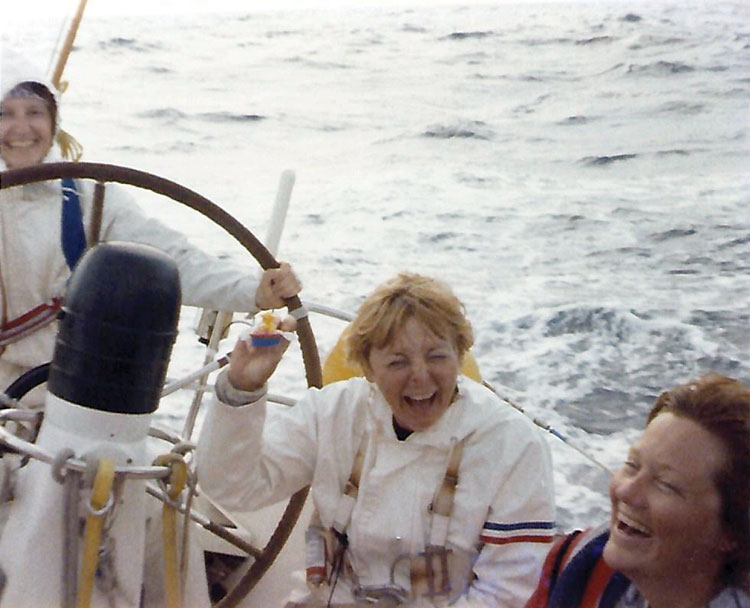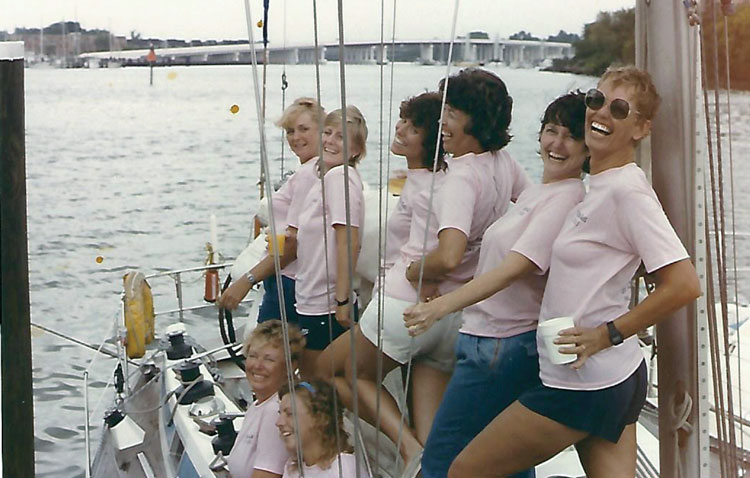Why do you do the Annapolis to Bermuda Race? To confront the challenge, to enhance your sailing resume, or for the romance of bluewater racing? All of these reasons were in the minds of the all-women crew of the Swan 37 William Tell, but not in the forefront. This historic team had been spurred on to be the first by the naysayers prevalent in the racing community in 1986.
In 1986 there was no Facebook, and there was no Twitter. There were, however, rumors galore on the “dock talk” circuits and chatter up the ying-yang at racers’ watering holes. The topic du jour in the summer of 1986 was the total disruption of racing mores in the Southern Chesapeake Bay: a group of women were going to race from Annapolis to Bermuda.
As the story goes, in a local event that had been run for women sailors the gentlemen organizers had decreed that the gals would not be allowed to use spinnakers. The reason being that the women were not experienced enough sailors. That was the final straw. Skipper/owner Ann Fraser (Norfolk), Sam Winters (Hampton), Joyce Dunn (Virginia Beach), Andi Overton (Virginia Beach), Terry Brown (Norfolk), Sherry Sharp (Portsmouth), ship’s doctor Clair Carman (Norfolk), and Joyce McEwen (Virginia Beach) used that attitude to strengthen their determination. As Fraser would later say to a local reporter, “It’s a challenge, not a crusade.”
So, there were planning sessions and boat preparation. The boat, a Swan 37, was hauled and evaluated, and appropriate maintenance and upgrading began. The crew did most of the work, although they did “allow” several men friends to paint the bottom. That was Tom Sawyer-ing Tom Sawyer, so to speak. The crew began to work out to get physically stronger. Mental improvement included studying mechanical and electrical systems and understanding the repair of each.
And, there were navigation skills to be sharpened. GPS on sailboats was generally unheard of in 1986. A condition of the race prohibited any boat from receiving supplies, weather reports, or position information on passing ships. Competitors were allowed four means of navigation: LORAN, SAT-NAV, dead reckoning, and celestial navigation. There was a lot more to navigation without the help of the electronic tools racers use today.

In those days, there were not many women racing on sailboats. Some of the crew—Fraser, Winters, Overton, Sharp, and McEwen—who had crewed on boats in local races, certainly had racing experience, but not everyone did. In fact one of the “unseasoned” suffered from sea sickness the second day out and spent the rest of the race green down below.
The race itself was not all sunny skies and gentle breezes. For all but the first day of the race the crew wore their foulies with long undies underneath. One of the crew, when they reached Bermuda, declared her foulies no longer wearable and threw them overboard. And, the reason for the ultra cautious use of water during the race was implemented just before the finish line. As Sam Winters said, “We were determined to have enough fresh water to shampoo our hair before crossing the finish line.” And, they did, so the crew of William Tell was probably the cleanest to ever finish the 753-nautical-mile-long race.
William Tell and crew finished the race 27th among the 55 boats racing. They received a trophy for the first-ever all women crew to do the Annapolis to Bermuda Race.
Today, it is not even noteworthy to see women, young and older, novice and experienced, involved in racing on the Southern Bay. They are very comfortably absorbed on big boats, small boats, and catamarans as part of co-ed teams or “all women” teams. In either case they are recognized for their sailing ability, reliability, and compatibility, as are all racers.
Today racing, from grassroots to championship levels, is one of the most gender-fair sports out here. It was not always so. However, thanks in a large part to the William Tell women and others like them, life on the race course is open to all.
To learn about the 2018 Annapolis to Bermuda Race, visit bermudaoceanrace.com. If you can’t wait that long to sail offshore, the Annapolis to Newport Race awaits you June 3: annapolisnewportrace.com.
by Lin McCarthy





